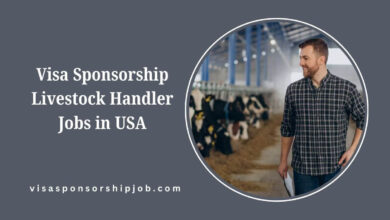Visa Sponsorship Sewing Jobs in USA – Apply Now
In its most basic form, sewing is the process of affixing materials through the use of threads that are either manually or mechanically executed. A wide variety of occupations in the United States industry of textile, apparel, and fashion, as well as manufacturing and customized stitching professions, are included in sewing employment.
The potential for skilled laborers in these professions is substantial. We will examine all the pertinent information regarding embroidery positions in the United States.
Key Points:
- Job Title: Sewing Professional (Various Roles)
- Location: United States (Multiple locations depending on employer)
- Visa Sponsorship: Available (H-2B, EB-3, or other relevant work visas)
Requirements for Visa Sponsorship Sewing Jobs in USA:
- Educational Background: The employment of SOC 261 occasionally necessitates a high school diploma or a general equivalency diploma (GED).
- Work experience in the textile industry, fashion design, or stitching may prove advantageous.
- Technical Proficiency: The candidate must possess a comprehensive understanding of the operation of stitching machines, the cutting of materials, and the manipulation of a variety of fabrics. Additionally, it is imperative to be acquainted with measurements, patterns, and modifications.
- Attention to Detail: In sewing positions, particularly those that involve fashion designer wear or made-to-order apparel, the degree of delicacy and closeness of work are crucial.
Check Also: Gallery Manager Jobs in USA Visa Sponsorship
Benefits of Visa Sponsorship Sewing Jobs:
- Legal Employment Status: Obtain the legal right to work in the country, thereby guaranteeing that you are safeguarded by labor laws.
- Job Security: Your employment is guaranteed with visa sponsorship, providing you with long-term stability and tranquility.
- Skill Development: You will have the chance to improve your tailoring abilities in a professional setting, thereby increasing your value in the industry.
- Enhanced Working Conditions: In comparison to non-sponsored laborers, numerous countries that implement visa sponsorship programs provide superior working conditions.
- Cultural Exposure: Working in a foreign country provides an opportunity to encounter new cultures and languages, thereby expanding one’s perspective.
- Networking Opportunities: Visa-sponsored positions frequently grant you access to professional networks that may result in improved career prospects.
- Pathway to Permanent Residency: Certain countries permit the transition from a temporary work visa to permanent residency.
- Employers that sponsor visas frequently offer competitive salaries, health insurance, and other benefits.
- Flexible Employment Opportunities: Visa sponsorship frequently includes the availability of a variety of sewing positions, including industrial, upholstery, and fashion stitching.
- Support for Relocation: Employers who sponsor your visa may also provide assistance with relocation costs and integrating into the country, thereby facilitating the transition.
Duties for Visa Sponsorship Sewing Jobs:
- Fabric Cutting and Measuring: It is crucial to adhere to the correct cutting and measuring procedures during the production process to ensure that the final product is manufactured to the correct specifications.
- Reading and Following Patterns: In order to manufacture specific textiles or garments, tailors and seamstresses must possess a comprehensive understanding of pattern instructions, layouts, and any other technical drawings.
- Altering Clothing: A variety of sewing jobs necessitate the modification of clothing, including hemming, resizing, or mending garments that have been damaged in some manner.
- Quality Control: Some of the job responsibilities include ensuring that the products are free of defects and that the seams have the appropriate number of stitching, as well as any visible loose threads.
Salary Expectations:
The compensation for sewing jobs in the United States is contingent upon factors such as the job description, experience, and the location of the job. Sewing professionals can anticipate an average salary of:
- Entry-Level Positions: $25,000 to $35,000 annually
- Experienced Sewers: This amount is typically between $35,000 and $50,000 annually.
- Specialized Positions (e.g., Pattern Makers, Tailors): The annual salary ranges from $40,000 to $60,000.
- Supervisory Positions: an annual salary of fifty to seventy thousand US dollars
Types of Jobs:
- A tailor is a professional who creates clothing for specific clients, modifies it by adding or subtracting sizes, and repairs it.
- Seamstress/Seamster: Sewers, tailors, or stitchers who sew and join clothing, accessories, or household textiles.
- Pattern Maker: Pattern makers are responsible for the creation of apparel patterns in accordance with the designer’s vision. They are also engaged in the production and preparation of garments.
- Costume Designer: Specialty costume designers, such as theatrical costume makers and tailors, are responsible for the design and stitching of costumes for stage burlesque, motion pictures, and other events.
- Upholsterer: Sewers are responsible for the fabrication and construction of furniture, transport vehicle seats, and other similar products.
- Embroidery Machine Operator: These employees employ embroidering machines to incorporate detail works, insignia, or brand logo designs into apparel and fashion fabrics.
- Garment Assembler: Garment assemblers are manufacturing laborers who are responsible for the sewing and assembly of garment components or other related accessories.
- Textile Worker: This industry employs a variety of individuals, including weavers, knitters, and spinners, as well as tailors who transform fabrics into practical items and quality controllers.
- Sewing Supervisor: Sewing supervisors are responsible for coordinating sewing sub-groups to ensure that the established production and quality objectives are met.
- Industrial Sewing Machine Operator: These professionals operate industrial sewing machines in a production environment and sew through thick fabrics, such as canvas or leather.
Job Application Process:
- Job search platforms: These platforms include social networks, job search websites, forums, employment-related boards, company websites, and traditional career sites.
- Create a Resume and Portfolio: Develop a resume that highlights your sewing experience, qualifications, abilities, and accomplishments. If it is feasible, include the portfolio of the most exceptional work completed thus far.
- Apply for Jobs Online: You may submit your resume and cover letter directly through the company’s website, currently available online employment search sites, or employment agencies that specialize in textile and sewing positions.
Frequently Asked Questions:
Can sewing become a career?
The sewing industry provides a vast variety of career opportunities in textile production, sales, retail, sewing, and manufacturing. Sewing industry jobs can involve the technical development or logistics of textile creation, along with the production and sale of clothing or other fabric items.
Is sewing a good life skill?
Sewing is a life skill that can save you time and money. In addition to those practical savings, sewing can be a tool for teaching important life skills such as perseverance, patience, concentration, and creativity.
What are the duties of a sewing operator?
Sewing machine operators use them to sew or decorate clothing and other products. They keep machines stocked with thread, place material under needles, and guide their stitching to sew parts together. These operators measure each finished product to ensure accuracy.




